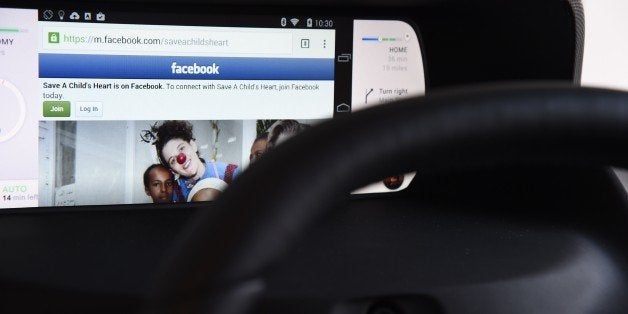FRANKFURT (Reuters) - Traffic jams in the future could cause potentially dangerous data snarl-ups as cars packed with entertainment, safety and navigation features vie for airwaves with smartphones, tablets and networked features in other vehicles, according to a study.
By 2024, mobile networks will see machine-to-machine (M2M) connections jump 10-fold to 2.3 billion from 250 million in 2014. Half these links will be automotive, said the study published on Thursday by Machina Research.
On the roads, about one in five vehicles worldwide will have some form of wireless network connection by 2020, or more than a quarter of a billion connected vehicles, according to a forecast from technology research firm Gartner.
Connected cars with onboard Wi-Fi connections could cause spikes in cellular data demand when traffic grinds to a halt as drivers seek alternative routes and bored passengers search for entertainment on phones and tablets, the Machina study says.
It says car navigation and collision detection systems that rely on local networks to identify obstacles could then become strained, if they are not carefully designed and regulated.
The report says the dangers will mount over the next decade but stops short of painting a picture of bloody roadside pile-ups. Such scenarios can be averted if network operators pay more attention to managing surging, unpredictable data demands in congested areas and device makers do more to ensure their products do not interfere with other network users.
"In terms of overall data volumes, connected cars don't present much of a problem," said Matt Hatton, founder and chief executive of Machina, a British market research firm specializing in machine-to-machine data communications.
"But network resource management is not based on total traffic volume. It's based on particular cell sites during peak times of network use," Hatton said of the antennas and equipment used to transfer mobile calls and data to and from a local area.
Peak traffic in rush hour could double in the immediate vicinity of congested areas due to the electronics on board connected cars, Machina estimates.
Already, most drivers stuck in traffic jams expect mobile phone coverage to drop out from the sheer volume of callers who suddenly find themselves bumper-to-bumper.
Less noticeably, phone users in densely populated areas can see superfast 4G data connections drop to slower 3G links or even 2G connections capable only of limited data transfers.
But while phones make minimal demands on a network until a user downloads a video, updates email or makes a call, network congestion multiplies when drivers converge in road traffic.
"Connected cars, as with other M2M devices, don't behave like smartphones," Hatton said, due in part to the vastly more diverse set of devices that will come into play with so many machines talking to other machines.
The Machina report was sponsored by TEOCO, a Fairfax, Virginia-based provider of network management services to major telecom network operators worldwide.
(Editing by David Clarke)
Support HuffPost
Our 2024 Coverage Needs You
Your Loyalty Means The World To Us
At HuffPost, we believe that everyone needs high-quality journalism, but we understand that not everyone can afford to pay for expensive news subscriptions. That is why we are committed to providing deeply reported, carefully fact-checked news that is freely accessible to everyone.
Whether you come to HuffPost for updates on the 2024 presidential race, hard-hitting investigations into critical issues facing our country today, or trending stories that make you laugh, we appreciate you. The truth is, news costs money to produce, and we are proud that we have never put our stories behind an expensive paywall.
Would you join us to help keep our stories free for all? Your contribution of as little as $2 will go a long way.
Can't afford to donate? Support HuffPost by creating a free account and log in while you read.
As Americans head to the polls in 2024, the very future of our country is at stake. At HuffPost, we believe that a free press is critical to creating well-informed voters. That's why our journalism is free for everyone, even though other newsrooms retreat behind expensive paywalls.
Our journalists will continue to cover the twists and turns during this historic presidential election. With your help, we'll bring you hard-hitting investigations, well-researched analysis and timely takes you can't find elsewhere. Reporting in this current political climate is a responsibility we do not take lightly, and we thank you for your support.
Contribute as little as $2 to keep our news free for all.
Can't afford to donate? Support HuffPost by creating a free account and log in while you read.
Dear HuffPost Reader
Thank you for your past contribution to HuffPost. We are sincerely grateful for readers like you who help us ensure that we can keep our journalism free for everyone.
The stakes are high this year, and our 2024 coverage could use continued support. Would you consider becoming a regular HuffPost contributor?
Dear HuffPost Reader
Thank you for your past contribution to HuffPost. We are sincerely grateful for readers like you who help us ensure that we can keep our journalism free for everyone.
The stakes are high this year, and our 2024 coverage could use continued support. If circumstances have changed since you last contributed, we hope you’ll consider contributing to HuffPost once more.
Already contributed? Log in to hide these messages.

